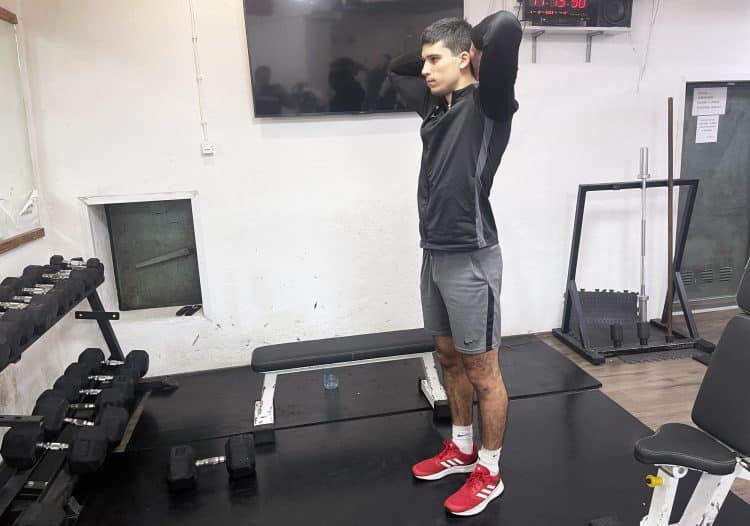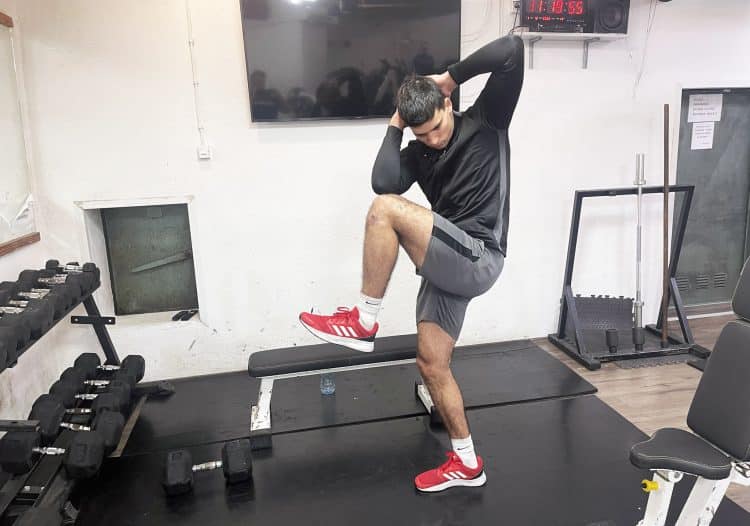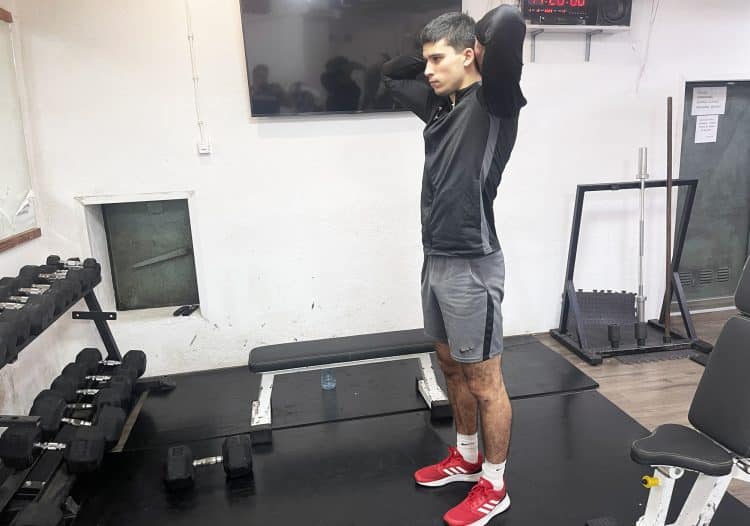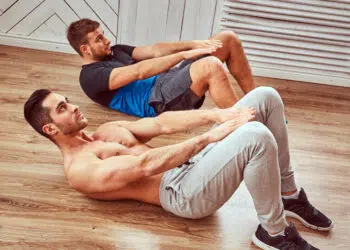As more and more people suffer from sedentary lifestyles, the quest for proper cardio and core exercises has never been more important.
A sedentary lifestyle often leads to weak glute and abdominal muscles, which is one of the biggest factors causing lower back pain.
In fact, one of the articles from Harvard Health Publishing titled “The real-world benefits of strengthening your core” claims that a strong core lessens wear and tear on the spine and allows you to breathe more deeply. (1)
A standing knee-to-elbow is one of those exercises I often implement to improve both my cardio and core strength.
As a Faculty of Sport and Physical Education student, I created an easy-to-follow guide on performing standing knee-to-elbow properly so you get the most out of this exercise.
In addition, you will also learn about the primary and secondary muscles targeted, their benefits, and, most importantly, some great variations and alternatives.
Level Up Your Fitness: Join our 💪 strong community in Fitness Volt Newsletter. Get daily inspiration, expert-backed workouts, nutrition tips, the latest in strength sports, and the support you need to reach your goals. Subscribe for free!
How to Perform a Standing Knee-to-Elbow Exercise
Below is an easy-to-follow guide on how to perform a standing knee-to-elbow exercise correctly.
Step One — Assume a Starting Standing Position
Assume a starting standing position with your feet close to shoulder-width apart. Keep your knees extended, hips neutral, and back in a straight line. Experiment with the width of your stance according to your personal preference. Place your hands behind your head.
Pro Tip: Retract (pulling them towards each other) your shoulder blades to activate them and keep your back more neutral. Shoulder blade retraction is an essential movement for all those suffering from thoracic kyphosis, which is almost everybody in these modern times of sedentary lifestyle choices. I implemented it regularly because I had problems with my thoracic spine, and it helped a lot.
Step Two — Connect Your Opposite Knee and Elbow
Touch your right elbow to your left knee. To do this, you must perform thoracic rotation and slightly internally rotate your left hip. Try to keep your back as flat as possible during this movement, even though it can be impossible for certain individuals due to their morphology.
Pro Tip: Isometrically contract all of the muscles of your left leg (leg on the floor) to gain enough stability to perform the entire exercise safely. This entails contracting your glutes, quads, hams, flexors, and calf muscles. I use this additional step all the time to achieve superior balance and reduce the chance of injury.
Step Three — Return to the Starting Position
Bring your right elbow and left knee back to the starting position. Make sure to do it with the utmost control to avoid injuring yourself. When you return to the starting position, hold it for a slight of a second before starting the next rep.
Pro Tip: Try envisioning the path your elbow and knee need to travel to return to the starting position. This is an excellent mental exercise for improving your hand and leg coordination while also ensuring you remain balanced throughout the entire range of motion. It helped me quite a lot when I had an elbow dislocation. This incident occurred when I was still playing basketball professionally.
Muscles Worked During Standing Knee-to-Elbows
Based on my biomechanical analysis of this movement, here are the primary muscles working:
- Rectus abdominis
- Obliques (internal and external)
Also, here are the secondary muscles working:
- Hip flexors
- Lower back muscles (erector spinae)
- Serratus anterior
Standing Knee-to-Elbow Benefits
Standing knee-to-elbow benefits include core strengthening, balance improvement, flexibility enhancement, coordination boost, and cardiovascular health support.
Let’s touch on each of these briefly.
Core Strengthening
Standing knee-to-elbow is an excellent exercise to strengthen your core muscles. These muscles include your rectus abdominis, obliquus internus, obliquus externus, and transversus abdominis.
They are primarily responsible for keeping your body stable during diverse types of movement while also protecting your lower back (lumbar spine) from entering lordosis (overarching position). I try to implement core exercises into every single workout I perform. This helped me develop a bulletproof core that protected my back from injury on numerous occasions.
Balance Improvement
By improving your core strength and endurance, you will improve your overall balance and posture. Improving your balance is crucial for so many reasons, and injury prevention is the most important one. (2)
When you teach your body to remain stable during complex movements, you drastically lower the chance of injury. This is especially important for athletes and older people as well.
Flexibility Enhancement
Flexibility and mobility are important so you can execute movements through the full range of motion. Firstly, this will allow you to improve your overall performance since you can execute a particular movement or technique precisely and efficiently.
Secondly, flexibility and mobility will also drastically lower the chance of injury. Standing knee-to-elbow will mainly focus on your thoracic mobility and lower body posterior chain muscle flexibility.
Coordination Boost
Your hand and leg movements that are performed simultaneously as a part of a single movement are very useful for improving your overall coordination as a motor ability. In this instance, you will likely develop contralateral coordination, which synchronizes the opposite upper and lower body limbs during the movement.
However, you should keep in mind that coordination benefits usually become insignificant after some time since your central nervous system (CNS) adapts.
Cardiovascular Health Support
Lastly, standing knee-to-elbow is an excellent exercise for improving your overall cardiovascular and respiratory fitness. However, what most fitness experts and enthusiasts need to say regarding cardio exercises is the following. The type of exercise you choose matters, but how you perform the exercise is more important.
To get the most of the cardio benefits, you need to stay in something called an aerobic zone. This zone is where you mostly burn oxygen to form energy (ATP – adenosine triphosphate). To make it simpler, you need to find the intensity where you can perform the exercise for a long time without getting tired quickly.
If you want to learn more about this subject, look for aerobic and anaerobic zones as the percentage of VO2 max.
What Are the Best Standing Knee-to-Elbow Variations and Alternatives?
The best standing knee-to-elbow variations and alternatives are standing oblique crunches, high knees, mountain climbers, Russian twists, and plank with knee-to-elbow.
Level Up Your Fitness: Join our 💪 strong community in Fitness Volt Newsletter. Get daily inspiration, expert-backed workouts, nutrition tips, the latest in strength sports, and the support you need to reach your goals. Subscribe for free!
If I could choose only one alternative or variation, I would go for mountain climbers. It always fascinates me how tiring this exercise is! Not only that, but it is effective at improving both your cardio and your core strength, which is very rare.
Now, let’s cover each of these variations and alternatives briefly.
Standing Oblique Crunches
Standing oblique crunches are excellent exercises for improving the strength of your lateral abdominal flexors.
Also, they are great for teaching your body to remain stable during complex movements on only one limb. In this sense, they are considered a unilateral exercise.
Steps:
- Assume a starting standing position with your feet shoulder-width apart.
- Place your left hand on your waist and lift your right hand above your head.
- Slightly open your right leg outwards by externally rotating your right hip.
- Connect your right elbow and right knee by adducting your right shoulder and abducting your right leg while keeping your right knee in the flexed position.
- When your right knee and elbow touch, hold that position for one second.
- Reverse the motion to return to the starting position.
- Repeat for the desired amount of reps.
https://www.youtube.com/watch?v=Z-erdZrQVCw&pp=ygUZU3RhbmRpbmcgT2JsaXF1ZSBDcnVuY2hlcw%3D%3D
Pro Tip: Try minimizing the lateral compensatory movement of your torso during the exercise. This will enable you to isolate internal and external obliques better.
High Knees
High knees is a highly demanding cardio exercise that will challenge your respiratory capabilities in a matter of seconds.
In fact, this exercise can be so intense that it is unlikely many fitness enthusiasts can perform it while staying in the aerobic zone. Often, you can see this exercise as a part of an athletic, dynamic warm-up.
Steps:
- Assume a starting standing position with your feet hip-width apart.
- Place your hands on your waist or leave them hanging on the sides if you wish to incorporate them into the exercise.
- Start the exercise by lifting your right leg. Do this by flexing your right hip while also keeping your right knee in the 90-degree flexed position in the end range of motion.
- Stop when your upper leg and torso enclose an angle of 90 degrees.
- As you bring your right leg down to the floor, simultaneously perform the same movement with your opposite leg.
- Alternate for the desired amount of reps or predetermined time.
Pro Tip: Incorporate abdominal breathing, more precisely exhaling, while bringing either one of your knees up. This will allow you to pull your knee upwards with more force by creating/releasing intra-abdominal pressure.
Mountain Climbers
Mountain climbers are also a fantastic cardio activity you can implement in your high-intensity interval training (HIIT) or as a standalone exercise in your workout.
They are extremely demanding on your cardiovascular and respiratory system and burn a significant amount of calories.
Steps:
- Assume a push-up position with your hands around shoulder-width apart.
- Make sure to keep your legs, butt, back, and head in line with each other.
- Start the exercise by pulling your right knee towards your chest as far as possible. Do this by flexing your right hips while simultaneously bending your knee and keeping it in that position in the end range of motion.
- When you reach the end range of motion, start bringing the same leg back to the starting position.
- While doing so, repeat the whole process with your left leg.
- Alternate your legs for the desired amount of reps or a predetermined amount of time.
Pro Tip: Contract your abdominal and glute muscles to prevent overarching your lower back and creating excessive lumbar lordosis. This will prevent injuring your back while also teaching your body to stabilize during different exercises and movements properly.
Russian Twists
Russian twists are another great core exercise in the transverse plane of motion. You will effectively teach your obliques to generate enough rotation power, which is quite useful in sports and daily activities as well.
Steps:
- Pick an appropriate weight plate or medicine ball and put it on the floor.
- Place a mat on the floor and sit on it.
- Slightly bend your legs so you move your heels closer to your butt.
- Pick the weight and hold it in your hands right in front of your chest.
- Lift your feet off the floor, and don’t drop them for the rest of the exercise.
- Start the exercise by twisting your body to your right side and moving the weight towards the floor.
- When the weight almost touches the floor close to your right hip, reverse the motion and repeat the entire sequence on the left side.
- Alternate for the desired amount of reps or on a predetermined amount of time:
Pro Tip: Never let the weight actually drop on the floor since that will enable your core muscles to rest more. Only twist and move the weight from side to side, but never let the plate or medicine ball rest with its entire weight on the floor.
Plank With Knee-to-Elbow
Plank with knee-to-elbow is another excellent core exercise that will challenge the overall stability and strength of the abdominal and hip muscles.
Steps:
- Assume a plank position.
- Keep your legs, butt, back, and head in line with each other.
- Start the exercise by connecting your right elbow and right knee.
- When you connect them, hold that position for one second.
- Reverse the motion to return to the starting position.
- Repeat for the desired amount of reps before changing the working arm and leg.
Pro Tip: Forcefully contract your core and glute muscles to prevent lateral movement in your hips. This will teach your core muscles to stabilize your body during complex movements properly.
FAQs
How does the standing knee-to-elbow exercise target different muscle groups compared to traditional ab crunches?
Actually, both of these exercises target the same muscles, including rectus abdominis, oblique muscles, erector spinae, and hip flexors, but in varying degrees. As far as the prime mover goes, the rectus abdominis is more activated during the traditional crunch exercise compared to the standing knee-to-elbow exercise.
Can the standing knee-to-elbow exercise be modified for beginners or those with limited mobility?
There are a couple of ways to modify a standing knee-to-elbow exercise for beginners or those with limited mobility. To modify the exercise, you can reduce the total range of motion, lower the pace, perform it while seated, incorporate wall support, execute partial movements, or use a prop like a ball or pillow.
What are the common mistakes to avoid while performing the standing knee-to-elbow exercise?
Some common mistakes to avoid while performing the standing knee-to-elbow exercise include improper posture, over-twisting, jerky movements, neglecting to breathe, lifting the shoulders towards the ear, overstaining the neck, and ignoring your core engagement.
Wrapping Up
Standing knee-to-elbow exercise is an excellent movement to strengthen the most important core muscles. In addition, you can easily improve your cardiovascular and respiratory fitness by regularly performing this exercise in your workout routine.
It also improves your thoracic mobility and lower body posterior chain flexibility, adding an overall injury prevention component to it. In the comments below, let me know your thoughts on the standing knee-to-elbow exercise and how you program it in your own workout regime.
References:
- https://www.health.harvard.edu/healthbeat/the-real-world-benefits-of-strengthening-your-core
- Al Attar WSA, Khaledi EH, Bakhsh JM, Faude O, Ghulam H, Sanders RH. Injury prevention programs that include balance training exercises reduce ankle injury rates among soccer players: a systematic review. J Physiother. 2022;68(3):165-173. doi:10.1016/j.jphys.2022.05.019
Relevant Articles:
- Ten Captain’s Chair Exercises for a Sculpted Midsection
- Cross-Body Crunch Exercise Guide and Videos
- How To Do In and Outs
Interested in measuring your progress? Check out our strength standards for Mountain Climbers, Russian Twist, Crunches.











